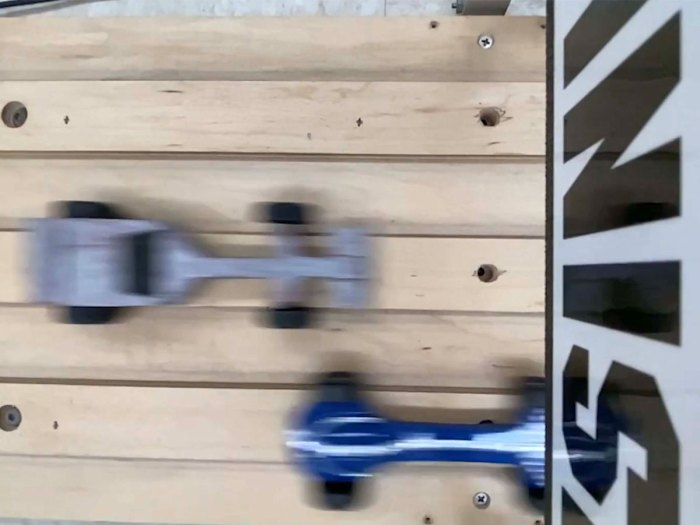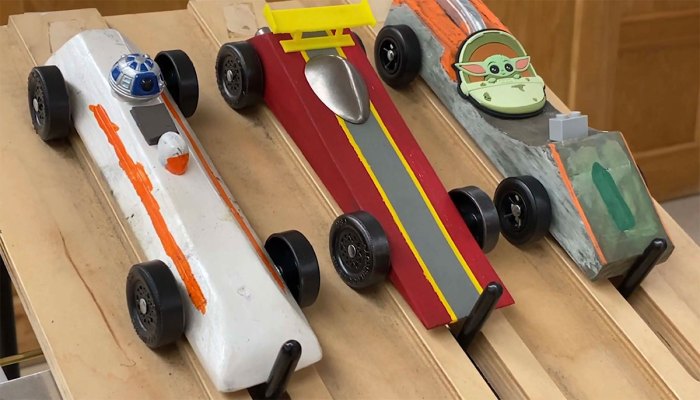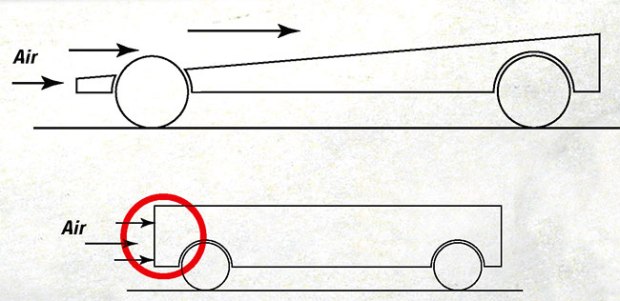How to Make a Fast Pinewood Derby Car

Packs nationwide are gearing up for their annual Pinewood Derby race, and the one thing everyone wants to know: How do I make a fast Pinewood Derby car?
There are a variety of ways to make your Pinewood Derby car go faster. Explore the following tips to optimize your car’s performance and gain a competitive edge in an upcoming race.
BASIC BUILDING GUIDELINES TO GET YOU STARTED
The possibilities are endless when it comes to creating a fast Pinewood Derby car. Before you begin, consider the following general guidelines:
Avoid Pointed Noses: A pointed nose will make it difficult for your car to rest on the pin at the starting gate. It may also cause your Pinewood Derby car to get bumped around when the pin drops, and it can create problems for electronic timing systems at the finish line.
Weight Distribution: Leave ample wood in the rear of the Pinewood Derby car so you can place additional weight there. Concentrate the majority of the weight in the rear for optimal performance.
Maximum Weight: Aim for the maximum allowable weight allowed by your pack’s rules, typically limited to 5 ounces in most races. If your car falls short of this weight, strategically add coins or other weights to meet the requirement.
Clarity in Orientation: Clearly distinguish the front and back of your Pinewood Derby car. In many races, the race officials — not you — will actually place each car on the track. Sometimes the officials put cars on the track backward because they can’t tell which end is which.
Aerodynamic Design: Select a design that facilitates smooth airflow over and around the car body. Pinewood Derby cars with aerodynamic profiles go faster.
Need design ideas? See photo galleries of hundreds of Pinewood Derby cars.

10 STEPS FOR DESIGNING AND BUILDING A FAST PINEWOOD DERBY CAR
You don’t have to strive for the fastest Pinewood Derby car to have fun competing in your Pinewood Derby. But if you and a helpful adult are willing to put in the extra time and effort, these speed tips are for you.
1. Bake the Block: Start your Pinewood Derby car project by baking the wood block at 250 degrees for two hours. This removes moisture and lightens the block, allowing you to place more weight at the rear of the car where you actually want it.

2. Crafting the Design: Outline your Pinewood Derby car on paper, cut it out, and affix it to the wood block.
Remember, a rectangular car is not an aerodynamic design. The most basic aerodynamic design is a simple wedge. If you don’t have time to design a complex car, a wedge will work just fine.
Download a Pinewood Derby car template PDF to help you create your design.
3. Rough Cut the Design: Use a coping saw or enlist the help of a responsible adult with a power tool to cut out the rough shape of your Pinewood Derby car.
4. Shape Your Car: Smooth edges and shape your car using sandpaper. An adult can assist with a rotary tool or other shaping tools.
5. Sand and Paint Creatively: Reduce friction by smoothing the car’s surface and paint an awesome design to make it look great.
How to paint your Pinewood Derby car to give it a shiny finish.
6. Axles and Wheels Alignment: Make sure they are aligned perfectly straight. You can test the alignment of your axles by pushing your car across a smooth floor or table. It should roll smoothly in a straight line.
- Consider a Three-Wheeler: Raise one wheel about 1/16 inch higher so it never actually touches the track. Less friction = more speed. Rules vary from pack to pack, so make sure to check your pack’s Pinewood Derby rules to make sure three wheelers are allowed in your race.
- Extend the Wheelbase: Maximize the distance between front and rear wheels. Again, make sure this is allowed in your race.
Inspect axles closely to make sure they are smooth without ridges or burrs. You can use sandpaper to remove any imperfections.
Learn about polishing Pinewood Derby axles and wheels to reduce friction.
7. Secure Axles with Glue: Glue the axles firmly in their holes to ensure that they stay perfectly placed, but make sure you don’t get glue on your wheels.
8. Strategic Weight Addition: Remember to make your Pinewood Derby car as heavy as the rules allow. In general, it’s best to place weight to the rear of your car because a heavier rear increases speed.
Learn scientific Pinewood Derby speed tips from a former NASA engineer.
9. Use Graphite: Add graphite or another dry lubricant to reduce friction. The less friction between the body and wheel, the better.
10. Have fun! And finally, remember the most important rule of a Pinewood Derby is that it’s supposed to be fun. While you should always strive to do your best, don’t get caught up in winning or having the fastest car. Just enjoy the ride.
Adapted from the book “Pinewood Derby Speed Secrets,” DK Publishing, $12.95 softcover.
Ideas for a car. Staple remover. Stapler. Crayon. Hedgehog. Ruler.
well i think this is cool except for one thing… around here in minnesota it’s cold and it’s snowing so i can’t go outside toget that booklet so right now i’m trying to find things for my pinewood derby car like some attachment that would make it better but i’m having trouble 😥 please help! P.S i think all i need is some tips like gresse or something for the wheels ofmy car so it can go faster, of course if it’s allowed.
To Tiger Tank, what did you do with your wheel alignment to make it different than it is? I am building a tank and would like the advice. Thanks!
i agree with riggo. aerodynamics has no effect on the car design. my dad did a test with a block and a totally aerodynamic car, and they both finished at the same time
If you have a perfectly flat car, be very careful. If you don’t position the weights just right, and too little weight, the car flies off the track. Be Prepared.
first car, kina hard.
i agree with durbykid. first cars are really hard. this is only my second time trying the derby. my dad wont work on it just because he doesnt no the date when its gonna be!!!
When you open the box of the car it has a set of rules and instructions. Read them it says to use the original axle slots. Extended wheel base is against the rules!!! You must use the original axle slots. You can straighten the slots. Only dry lubricant is allowed no oil. Axles can be polished only and the burrs removed and the wheels can have the spot that is from the mold sanded smooth.
some car plans call for the extended wheel base, we went to the district and they removed the rule stating that you have to use the original axel slots.
Too bad, I guess it depends on where you live. In our area, all of the winning cars had extended wheel bases. I guess it is up to the local rules.
My son won his pack races using the speed tips in Mr. Meade’s book. After the races, our pack leader stated that our extended wheelbase “might not” pass district inspections. He also stated the axles must be viewable. Neither the pack or disctrict rules mention anything about using original axles slots or that the axles must be viewable. The wheels and axles must not be modified, but there is no mention of the axle slots themselves. We don’t want to modify our car if it ends up being allowed, nor do we want to be at a disadvantage if it is allowed. Anyone else run into this type thing? Thoughts? Ideas?
~ for clarification ~
Exact local rules:
Car Specifications:
I. Width .. not greater than 2 3/4 inches.
2. Length .. not longer than 7 inches.
3. Gross weight .. shall not exceed 5 ounces.
4. Width between wheels .. 1 3/4 inches
5. Clearance .. no less than 3/8 inch.
6. Height .. 3 inches max.
Car Rules:
I. Wheel bearings, washers, bushings and springs are prohibited.
2. Only official Cub Scout Grand Prix Pinewood Derby wheels and axles are permitted.
3. The car shall be freewheeling with no starting device(s).
4. Only dry type lubricant is permitted. (Graphite).
5. Wheels and axles may not be altered. Wheels and axles may be polished to remove imperfections. No changes to the size or shape of the wheels and axles are permitted.
6. The entire car must line up behind the starting post.
7. Weights must be fastened securely and paint shall be dry.
Race Rules:
I. Cars shall be inspected, and then weighed on the official race scale. Cars will be checked to assure that none of the construction limitations have been exceeded.
Ask you pack if there are specific rules they abide by. Same goes with the district or council. My pack had a set of rules we used and removed the originals out of the boxes before handing them out. Any car that did not follow the rules was disqualified. It was unfortunate but it was stated before the cars were pasted out to the boys.
Today and yesterday I worked on a pinewood derby car, just for fun. I know it is agenced the rules to use oil but I dont have a derby coming up so I gess It’s ok
I did not win a trophy but i won a medal
I one a metal to. I got secend place in my pack. Their is three guys in my den.